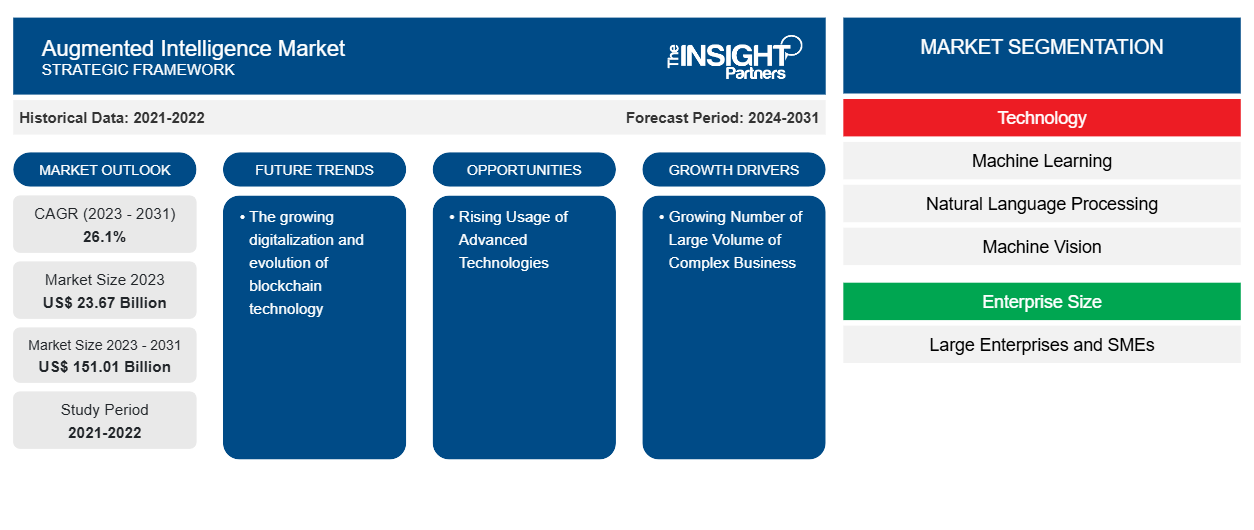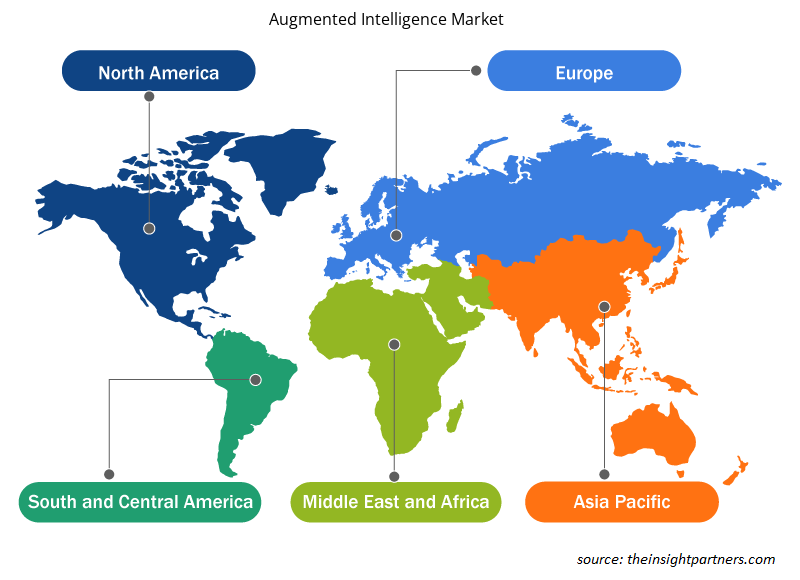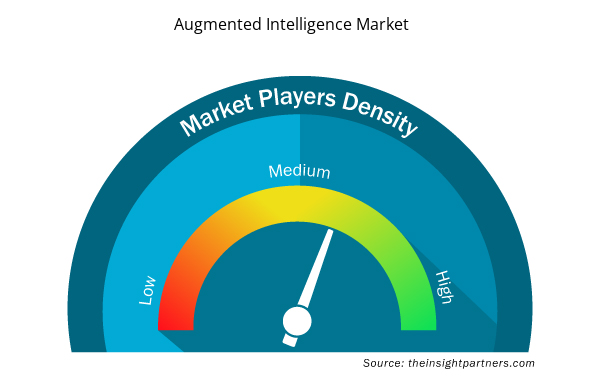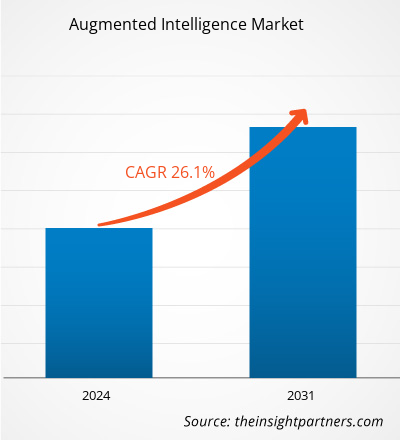The augmented intelligence market size is projected to reach US$ 151.01 billion by 2031 from US$ 23.67 billion in 2023. The market is expected to register a CAGR of 26.1% in 2023–2031. The growing digitalization and evolution of blockchain technology are likely to remain a key augmented intelligence market trend.
Augmented Intelligence Market Analysis
The augmented intelligence market is growing at a rapid pace due to the growing number of large volumes of complex business data and expanding BFSI, IT & telecom, and retail and e-commerce industries. The market is expanding steadily, driven by the growing adoption of augmented intelligence among SMEs. Moreover, the rising usage of advanced technologies and increasing adoption of cloud-based solutions among businesses are providing lucrative opportunities for market growth.
Augmented Intelligence Market Overview
Augmented intelligence is a type of artificial intelligence that focuses on AI's assistive capabilities. In addition, augmented intelligence is being created to support organizations in making more accurate data-driven decisions in business and daily life. Furthermore, augmented intelligence is used by companies to improve their employee performance and assists the organization in understanding the employees' areas for improvement is driving the market. Additionally, augmented intelligence is the most effective technique to use and prioritize a big collection of security data by giving predictive analytics to enterprises.
Customize This Report To Suit Your Requirement
You will get customization on any report - free of charge - including parts of this report, or country-level analysis, Excel Data pack, as well as avail great offers and discounts for start-ups & universities
Augmented Intelligence Market: Strategic Insights

- Get Top Key Market Trends of this report.This FREE sample will include data analysis, ranging from market trends to estimates and forecasts.
You will get customization on any report - free of charge - including parts of this report, or country-level analysis, Excel Data pack, as well as avail great offers and discounts for start-ups & universities
Augmented Intelligence Market: Strategic Insights

- Get Top Key Market Trends of this report.This FREE sample will include data analysis, ranging from market trends to estimates and forecasts.
Augmented Intelligence Market Drivers and Opportunities
Growing Number of Large Volume of Complex Business Data is Driving the Market
Augmented intelligence technologies, such as machine learning and natural language processing, are becoming increasingly important for data analysis. Augmented intelligence enables the analysis of organized, semi-structured, and unstructured data sources stored within companies. The variety and high volume of data created are projected to rise significantly in the coming years associated with the expanding industries and evolution of digital technologies across company operations. This increases the demand for augmented intelligence solutions among companies for effectively and efficiently managing their large volume of data. However, the growing volume of complicated data is projected to fuel the augmented intelligence market during the anticipated time period.
Rising Usage of Advanced Technologies – An Opportunity in the Augmented Intelligence Market
Rising usage of advanced technologies such as artificial intelligence, machine learning, and natural language processing technologies are creating opportunities for market growth during the forecast period. Many industries, such as IT and telecommunication, retail and e-commerce, BFSI, healthcare, and others, are generating vast volumes of data and require advanced technologies for analyzing this data in real-time, which increases the demand for augmented intelligence solutions. Industries are adopting new technologies such as artificial intelligence, machine learning, and natural language processing for analyzing vast data by making effective decisions in real time. These tools have simplified the process of extracting insights from data, which increases its adoption and creates opportunities in the market.
Augmented Intelligence Market Report Segmentation Analysis
Key segments that contributed to the derivation of the augmented intelligence market analysis are technology, enterprise size, and end-user
- Based on technology, the augmented intelligence market is divided into machine learning, natural language processing, machine vision, context-aware computing, and others. The machine learning segment held a larger market share in 2023.
- In terms of enterprise size, the market is segmented into large enterprises and SMEs. The SMEs segment held a larger market share in 2023.
- In terms of end-user, the market is categorized as IT and telecommunication, retail and e-commerce, BFSI, healthcare, and others. The BFSI segment held a larger market share in 2023.
Augmented Intelligence Market Share Analysis by Geography
The geographic scope of the augmented intelligence market report is mainly divided into five regions: North America, Asia Pacific, Europe, Middle East & Africa, and South America/South & Central America.
In terms of revenue, North America accounted for the largest augmented intelligence market share, due to the technological advancement and presence of key players, including IBM Corporation, Microsoft Corporation, TIBCO Software Inc., Salesforce.com, Inc., and MicroStrategy Incorporated. These players are significantly investing in adopting advanced technologies such as AI, ML, and NLP and are continuously engaged in developing these technologies by adding additional features. Rising demand for cloud-based augmented intelligence among industries including IT & telecommunication, BFSI, retail & e-commerce, healthcare, and others are projected to boost the market in North America.
Augmented Intelligence Market Regional Insights
The regional trends and factors influencing the Augmented Intelligence Market throughout the forecast period have been thoroughly explained by the analysts at Insight Partners. This section also discusses Augmented Intelligence Market segments and geography across North America, Europe, Asia Pacific, Middle East and Africa, and South and Central America.

- Get the Regional Specific Data for Augmented Intelligence Market
Augmented Intelligence Market Report Scope
| Report Attribute | Details |
|---|---|
| Market size in 2023 | US$ 23.67 Billion |
| Market Size by 2031 | US$ 151.01 Billion |
| Global CAGR (2023 - 2031) | 26.1% |
| Historical Data | 2021-2022 |
| Forecast period | 2024-2031 |
| Segments Covered |
By Technology
|
| Regions and Countries Covered | North America
|
| Market leaders and key company profiles |
Augmented Intelligence Market Players Density: Understanding Its Impact on Business Dynamics
The Augmented Intelligence Market is growing rapidly, driven by increasing end-user demand due to factors such as evolving consumer preferences, technological advancements, and greater awareness of the product's benefits. As demand rises, businesses are expanding their offerings, innovating to meet consumer needs, and capitalizing on emerging trends, which further fuels market growth.
Market players density refers to the distribution of firms or companies operating within a particular market or industry. It indicates how many competitors (market players) are present in a given market space relative to its size or total market value.
Major Companies operating in the Augmented Intelligence Market are:
- IBM Corporation
- Microsoft Corporation
- SAP SE
- TIBCO Software Inc.
- Sisense Inc.
- Salesforce.com, Inc.
Disclaimer: The companies listed above are not ranked in any particular order.

- Get the Augmented Intelligence Market top key players overview
Augmented Intelligence Market News and Recent Developments
The augmented intelligence market is evaluated by gathering qualitative and quantitative data post primary and secondary research, which includes important corporate publications, association data, and databases. The following is a list of developments in the market for augmented intelligence and strategies:
- In September 2023, Oracle Corp today showcased new AI-powered capabilities within Oracle Analytics Cloud. The new self-service AI capabilities, including generative AI assistants and augmented analytics, help organizations improve how data impacts decision-making. (Source: Oracle Corp, Press Release, 2023)
Augmented Intelligence Market Report Coverage and Deliverables
The “Augmented Intelligence Market Size and Forecast (2021–2031)” report provides a detailed analysis of the market covering below areas:
- Market size and forecast at global, regional, and country levels for all the key market segments covered under the scope
- Market dynamics such as drivers, restraints, and key opportunities
- Key future trends
- Detailed PEST/Porter’s Five Forces and SWOT analysis
- Global and regional market analysis covering key market trends, major players, regulations, and recent market developments
- Industry landscape and competition analysis covering market concentration, heat map analysis, prominent players, and recent developments
- Detailed company profiles
- Historical Analysis (2 Years), Base Year, Forecast (7 Years) with CAGR
- PEST and SWOT Analysis
- Market Size Value / Volume - Global, Regional, Country
- Industry and Competitive Landscape
- Excel Dataset



Report Coverage
Revenue forecast, Company Analysis, Industry landscape, Growth factors, and Trends

Segment Covered
Technology , Enterprise Size , End-User , and Geography

Regional Scope
North America, Europe, Asia Pacific, Middle East & Africa, South & Central America

Country Scope
Argentina, Australia, Brazil, Canada, China, France, Germany, India, Italy, Japan, Mexico, Russian Federation, Saudi Arabia, South Africa, South Korea, United Arab Emirates, United Kingdom, United States
Frequently Asked Questions
What is the estimated market size for the global augmented intelligence market in 2023?
The global augmented intelligence market was estimated to be US$ 23.67 billion in 2023 and is expected to grow at a CAGR of 26.1% during the forecast period 2023 - 2031.
What are the driving factors impacting the global augmented intelligence market?
The growing number of large volumes of complex business data and expanding BFSI, IT & telecom, and retail and e-commerce industries are the major factors that propel the global augmented intelligence market.
What are the future trends of the global augmented intelligence market?
The growing digitalization and evolution of blockchain technology to play a significant role in the global augmented intelligence market in the coming years.
Which are the key players holding the major market share of the global augmented intelligence market?
The key players holding majority shares in the global augmented intelligence market are IBM Corporation, Microsoft Corporation, SAP SE, TIBCO Software Inc., and Sisense Inc.
What will be the market size of the global augmented intelligence market by 2031?
The global augmented intelligence market is expected to reach US$ 151.01 billion by 2031.
What is the incremental growth of the global augmented intelligence market during the forecast period?
The incremental growth expected to be recorded for the global augmented intelligence market during the forecast period is US$ 127.34 billion.

 Get Free Sample For
Get Free Sample For